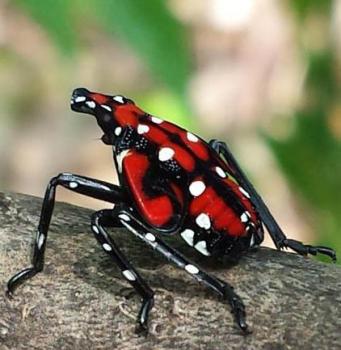Need to Report an Invasive Insect?
Did you find a spotted lanternfly, box tree moth, elm zigzag sawfly or Asian longhorned beetle life stage or damage to a tree or shrub? Don't know who to contact? We've got you covered...
Spotted lanternfly, box tree moth, elm zigzag sawfly, and Asian longhorned beetle are all present in Massachusetts. Reporting new locations where each of these insects is found is still very important. In Massacusetts, you can report each in the following ways:
- Spotted Lanternfly Report Form
- Box Tree Moth Report Form
- Elm Zigzag Sawfly Report Form
- Asian Longhorned Beetle (ALB) Report Form or call the ALB Eradication Program at 508-852-8090.
If you have observed one of these insects or the damage they cause in a state other than Massachusetts, you can search by your state and find how to report on the USDA Animal and Plant Health Inspection Service (APHIS) website.
Not sure what to look for when?
Each of these insects has their own life cycle, periods of activity, and preferred host plants.
This table summarizes some of this information. |
|||||||||
Name |
Host Plants* |
April |
May |
June |
July |
August |
September |
October |
November |
| Spotted lanternfly | Tree of heaven, grape, black walnut, & many others. | Overwintering egg masses. Egg hatch by late April/early May and may last into June. | 1st and 2nd, instar nymphs maturing. | 1st, 2nd, and 3rd instar nymphs maturing depending upon timing of egg hatch. | 4th instar nymphs (black, white, and red) & possibly adults at the end of the month. | 4th instar nymphs (black, white, and red) & adults. | Adults & newly laid egg masses. | Adults killed by frost. Egg masses overwinter. | Egg masses overwinter. |
|
Box tree moth*
*Life cycle in MA is not fully understood. |
Boxwood (Buxus spp.) | Eggs, adults, larvae and pupae may be present. | Eggs, adults, larvae and pupae may be present. | Overwintering generation larvae may still be present. Subsequent generation adults, eggs, and pupae may be present. | Subsequent generation eggs, adults, larvae and pupae may be present. | Subsequent generation eggs, adults, larvae and pupae may be present. | Subsequent generation eggs, adults, larvae and pupae may be present. | Subsequent generation eggs, adults, larvae and pupae may be present. | Overwintering caterpillar life stage present in cocoons protected by webbing on the leaves of host plants. |
|
Elm zigzag sawfly*
*Life cycle in MA is not fully understood. |
Elm (Ulmus spp.) | Adults may emerge by the end of April. | Adults may emerge by the beginning of May, or when temperatures warm and leaves are available. Egg laying takes 1-6 days. | Egg hatch can take 4-8 days and caterpillars feed 15-18 days prior to pupating. | Caterpillars, pupae, and adults of subsequent generations possible. | Caterpillars, pupae, and adults of subsequent generations possible. | Caterpillars, pupae, and adults of subsequent generations possible. | Overwintering pupal life stage in densely walled cocoons often in the leaf litter or nearby soil. | Overwintering pupal life stage in densely walled cocoons often in the leaf litter or nearby soil. |
| Asian longhorned beetle | Maple (Acer spp.), birch, elm, willow, horse chestnut and others. | Overwintered larvae may fully mature in preparation to pupate. In New England, larvae may need to be in trees for 2 years before pupation. | Various instar larvae & pupae within trees. | Various instar larvae & pupae within trees. | Adult emergence by July 1. Perfectly round exit holes that a pencil can fit inside may be present in tree. | Adults may be present & laying eggs. Egg sites will be visible on host plant bark. | Adults may be present but are eventually killed by frost. | Larvae tunnel deep into the wood of their host plants to overwinter. | Larvae tunnel deep into the wood of their host plants to overwinter. Old egg sites, exit holes, and open galleries are still visible in trees. |
*This is an abbreviated list of preferred host plants. See UMass Extension's Professional Insect & Mite Management Guide for Woody Plants for more information.
Early reporting is essential for successful management of these insects! If you find them or the damage they cause, note your exact location (physical address or GPS coordinates), the date of the observation, and take photos! Collect a specimen if it is safe to do so, but take a clear, up-close, and in-focus photo first. This helps in case the insect escapes being caught. Thank you!
Tawny Simisky, UMass Extension Entomologist
